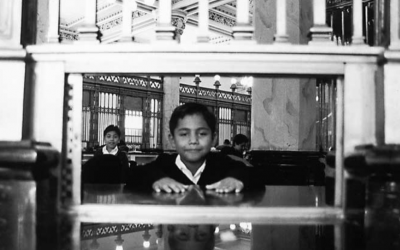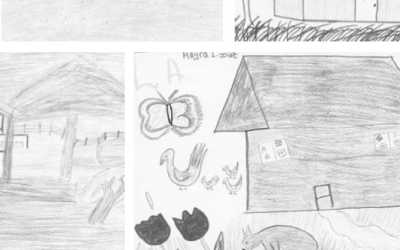Academia Boston de las Artes
Transforming Education in Argentina

Scenes from Argentina: dancing, making art, showing off drawings. Ramiro Gonzalez.
The Pedro Goyena school no. 21 sits on a dusty street in the remote town of Charata in northwestern Argentina. The flat soybean fields in this region go for miles, and the heat can reach 120 degrees in the summer. The next town is 45 minutes away. I stepped out of a 1970s-vintage taxi onto the dirt sidewalk and walked into the school’s courtyard, which also functions as a gathering place for exhibitions and performances. I visited six public high schools, including Pedro Goyena, in Argentina last November. I witnessed a remarkable transformation taking place in collaboration with my own school, the Boston Arts Academy. Inspired by our success in creating an arts-intensive urban school that serves an enormously diverse group of students, a unique school reform project is now in its third year of implementation there. The project, funded by four local foundations and receiving support (but no extra funding) by the Argentine Ministry of Education, is known there as “Academia Boston de las Artes.”
Pedro Goyena’s principal Patricia Avila conducted a whirlwind tour for myself and a Boston Arts Academy teacher. We started in an excellent math class in which students were building a batterypowered Ferris wheel all with polygons and solving a jig-saw puzzle with algebraic formulas. From there we went to the “Multiple Intelligences Room,” inspired by Howard Gardner’s famous theory of learning, which also functions as a library with a collection of perhaps 100 books. This room, funded in large part by the project, is the centerpiece of much of the new pedagogy in the school. Here, students, teachers, and parents can use print resources to plan more arts-based lessons. Students were working on anthologies of their favorite poets and also writing their own poetry and stories, then sewing the books together and illustrating each page. The construction paper they used was not exactly of rare-book collection quality, but the pride with which the students showed me their work told me something special was taking place here.
The photography classroom had only a makeshift lab and a very limited chemical supply, but the students reported that they had already been hired by the municipality to work on a new town history. With enormous satisfaction they showed me photos they had taken of historical landmarks and houses in the town. They explained that this would be the first time any of their work would be published. “No one knew the history of any of these buildings. We are the first to really tell this story. See this building. There was actually a small theatre here over fifty years ago. Many people say that this town had more activity then. These pictures will go in a book. Then the story of Charata will be known. More of us will be proud to come from here.” The teachers nodded as their students spoke. “This is the kind of authentic work that makes the students really want to come to school.” I asked if any of the students had thought about pursuing a career in journalism or photography after high school. “No,” a lanky dark hair girl answered, “but I am going to try and go to college. I know I have good ideas. I didn’t really know that before.”
A sign on the wall of one classroom read “We are not responsible for the face we are given, just the face we put on.” Almost everyone at Pedro Goyena told us the same story, about how the school district refused to put fencing around the school even after the well pump had been stolen three different times, leaving the school without fresh water. Avila had wanted to hire a night watchman, but there was no money. Yet there was an upbeat mood to the school. Students put on a wonderful show for us, of tango, mime and song. They were overjoyed that we had come to visit.
All six of the schools we visited serve students from poor and working-class families in urban, rural or semi-rural regions of the provinces of Buenos Aires, Chaco and Santa Fe. The project seeks to reduce student drop-out rates, increase student achievement and improve teachers’ content knowledge. Each school is discovering its own way to integrate the arts into its curriculum, but all share a conviction that arts can transform student learning, teachers’ pedagogy, family involvement and the very nature of the school culture and community.
The project evolves from the idea that the language of arts and culture allows students to experience alternative paths of learning and of demonstrating their knowledge. Teachers are equally affected. When exposed to different ways of thinking about teaching, they can change their own methods and even their long-held beliefs (often negative) about students. More than 4,000 students and 700 teachers have participated in the Academia Boston de las Artes project over the past three years. More schools are now being selected to be members of a larger vanguard of public schools in Argentina determined to bring arts back into education.
None of the schools we visited look very impressive physically. One is housed in a converted factory building (much like the Boston Arts Academy). Another sits on the outskirts of town in Santa Fe in a new building that is already bursting at the seams from overcrowding. Energy and life explode from every corner of this building. You can barely hear in the math classrooms because of the drumming next door. Theater rehearsals take place in a crowded classroom that is also used for academic classes. The Academia Boston de las Artes has enabled them to acquire some radio, video and photography equipment, theater supplies, music, newspapers and literary magazines.
All of us were moved by the way teachers and students at Pedro Goyena were able to achieve such a high level of artistic and academic understanding with so few resources, and by their obvious commitment to their work. At the end of the day we asked the teachers how the project had been going. They explained that they could not stay long to talk: they were “taxi teachers,” which means that they had to leave immediately to teach in another school 45 minutes away in order to earn their salary. But they stayed long enough to say that the arts had enriched everyone’s lives.
“Our students need to express themselves,” said one teacher, Lidia, “whether in song, in writing, taking pictures, or constructing shapes in math class. Our students feel that they belong here now and they will stay well after school is finished to practice their music or develop their pictures. And for us, our attitude has changed. The teaching situation is so bad in Chaco, but we have received professional development and learned that there are other methods that can be applied in the classroom. The use of art has helped us understand our students better. We now can see that they really do learn in different ways. Multiple intelligences do exist.”
At Hermoso Campo, a small and even poorer town in the same region as Charata, we found that students had painted murals on every possible wall, and everyone took real pride in the school’s tiny radio station. The windowless library that had been built as an annex to the main building had to be used full-time as a classroom, but the teachers were hoping that the district would allow them to build another building one day.
Estela, one of the original teachers in the project, showed me the books her students had written and illustrated. “I want to publish them,” she said, “but where will the money come from? The primary school in town has so few books. These could be the beginning of their library.” I had first met Estela three years before. She had been skeptical that anything good would ever come to her small town. Now she was looking to publish her students’ writing and seeking foundation support for the project.
We watched student videos at Hermoso Campo and were struck by their detailed research and storyboard skills, all done without a computer or editing equipment. The students were making a video about our visit, and they interviewed us on our way out. “What will you take away from our school?” a girl of about 16 asked me. “Your commitment to learning,” I said without hesitating. “I am impressed with how you all want to learn in new ways and how your teachers want to teach in new ways.”
In the province of Santa Fe, we visited a school with more than 600 students where everyone was showcasing their work. It was truly a whole-school exhibition. Students sat at desks with science projects, art projects, essays, poems, and all sorts of small-business ventures, selling bread, perfume, lamps, jewelry, soap. Art had become the focus of entrepreneurship classes. At the assembly, the entire school, along with parents and many babies (there are a number of single parents in this school), crowded into the multi-purpose room to hear the school band. Everyone knew the tune and chimed in, but the most compelling moment came when the drummer, Edwin, approached the stage holding a creased paper, his hand shaking. He began to read.
“Three years ago this room didn’t even exist,” he said. “This project has allowed us to build this room, and this stage, and bring music to our school. Three years ago I didn’t think I would even finish high school. Today I stand here before you, my teachers, and many parents and fellow students, and I tell you that I am changed. My class has changed. We have been able to express our creativity. We have been able to sing about what is important to us. We have been able to create something. I am finishing school. I am going to be somebody. I thank you, teachers, for what you have done.”
At every school, the project grant managers, district supervisors, school administrators, teachers, and students told me the same things: Classrooms were more alive now. Teachers took risks—we even visited a classroom where two teachers team-taught, a radical idea in Latin America. There was a better relationship between students and teachers, and between students and students. Arts had helped to break down social class barriers. The teachers, too, had begun to express themselves, and to believe in their own potential for creating better schools.
Everyone talked about how school now felt like something worth belonging to. Everyone talked about their pride in the art that students were creating. Everyone talked about the involvement of parents and the community. No one felt like the work was over. Economic troubles, low pay scales, natural disasters, and, in the urban schools, all the complex problems that accompany city life, threatened to wipe out the hard-earned advances these six schools had made. But everyone was committed to continuing. I hope to return to Argentina in three years and to find many more schools involved in the project, with local artists contributing and more foundations and private citizens working to improve the public schools. For now, at least, Academia Boston de las Artes is alive and well in Argentina.
Winter 2004, Volume III, Number 2
Linda Nathan is the founding headmaster at Boston Arts Academy, a pilot high school in the Boston Public School System. She can be reached at lnathan@boston.k12.ma.us or 617-635-6470. She is also a Lecturer at Harvard Graduate School of Education.
Related Articles
Editor’s Letter: The Children
A blue whale spurts water joyfully into an Andean sky on my office door. A rainbow glitters among a feast of animals and palm trees. Geometrical lightning tosses tiny houses into the air with the force of a tropical hurricane.
Centroamerica
Cuando Pedro Pirir, fue despedido del taller mecánico donde trabajaba desde hacía muchos años, experimentó una sensación de injusticia y pena que luego se transformó en una voluntad…
Irregular Armed Forces and their Role in Politics and State Formation
As I sat in heavy traffic in the back of a police car during rush hour in the grimy northern zone of Rio de Janeiro, I studied the faces of drivers in neighboring cars, wondering what they thought of…




